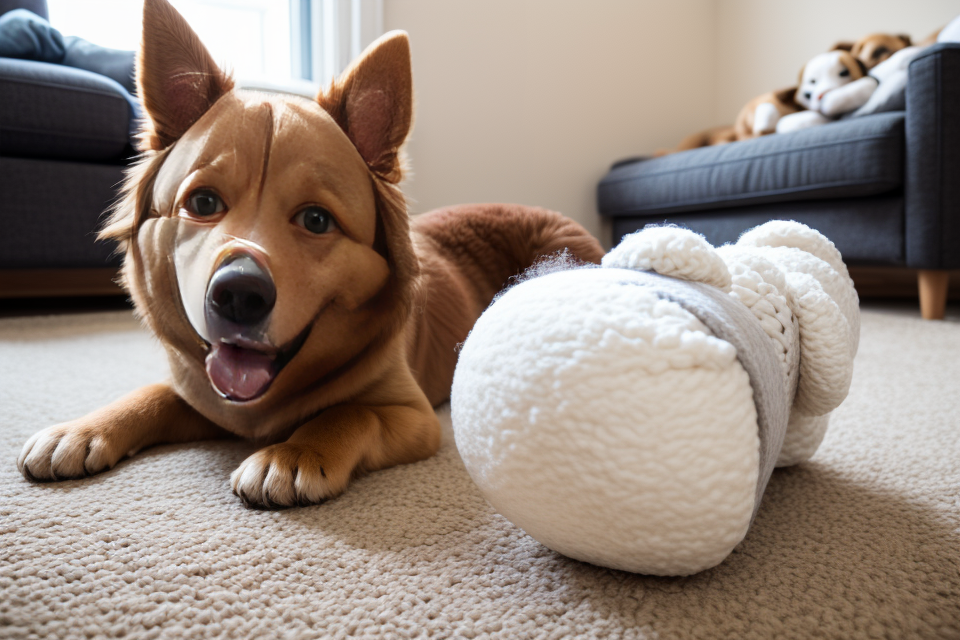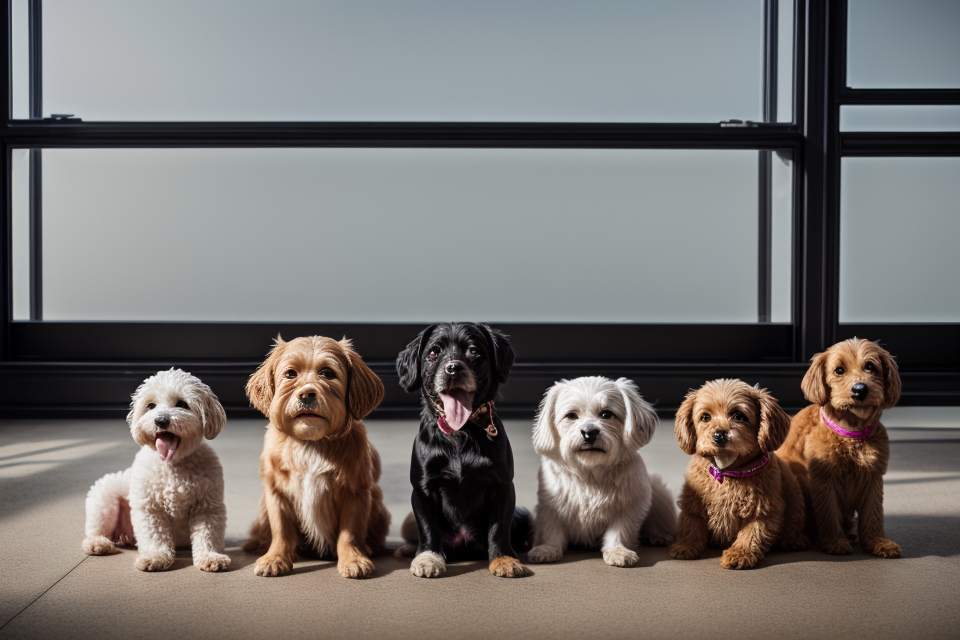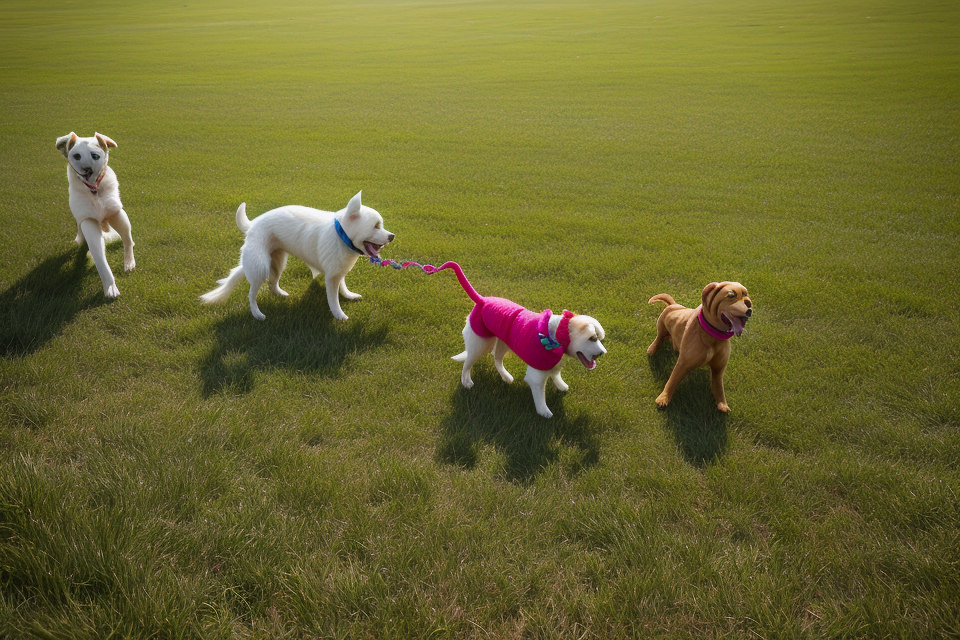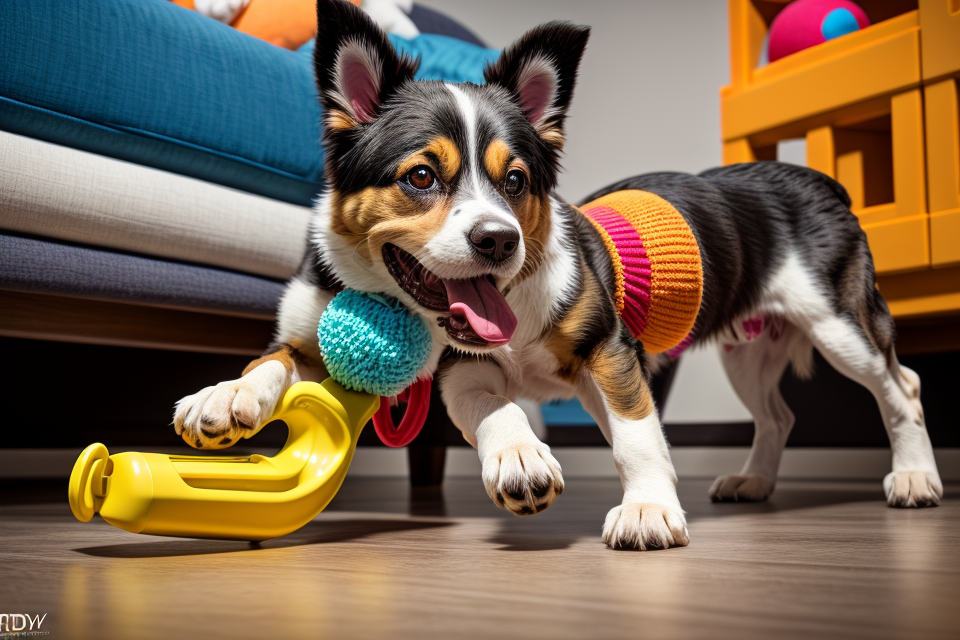As a dog owner, it’s natural to want to provide your furry friend with the best toys and treats. But when it comes to wool toys, the question remains – are they safe for dogs? Some people swear by wool toys, claiming that they are gentle on a dog’s teeth and gums, while others warn of the potential dangers of wool fibers getting stuck in a dog’s digestive system. So, what’s the truth? In this article, we’ll explore the pros and cons of wool toys for dogs, and help you make an informed decision about what’s best for your pet.
Yes, it is generally safe for dogs to play with wool toys. Wool is a natural material that is often used to make dog toys because it is soft, durable, and can be chewed on without posing a risk of harm to the dog. However, it is important to note that some dogs may be allergic to wool or may be able to swallow large pieces of it, so it is important to monitor your dog while they are playing with a wool toy and to remove the toy if your dog shows any signs of distress. Additionally, it is important to make sure that the wool toy is not contaminated with any harmful substances before giving it to your dog.
Understanding the Material
What is wool?
Wool is a natural fiber that comes from sheep, goats, and other animals with fur. It is a protein-based material called keratin, which is the same material that makes up our hair and nails. Wool is a versatile and durable fiber that has been used for clothing and textiles for thousands of years. It is also a popular material for making dog toys, as it is soft, lightweight, and easy to chew.
Wool is made up of a series of overlapping fibers that are tightly packed together. These fibers are very strong and elastic, which makes wool resistant to tearing and stretching. Wool is also a natural insulator, which means it can keep a dog warm in cold weather and cool in hot weather. This makes wool an ideal material for dog toys, as it can withstand the wear and tear of playtime without breaking or becoming damaged.
Wool is also a natural material that is biodegradable and eco-friendly. Unlike synthetic materials, wool can break down naturally and is not harmful to the environment. This makes wool a great choice for dog owners who are looking for safe and sustainable toys for their pets.
In summary, wool is a natural, durable, and eco-friendly material that is ideal for making dog toys. It is strong, lightweight, and easy to chew, making it perfect for playtime. Additionally, wool is a natural insulator, which means it can keep a dog warm or cool depending on the weather. All of these factors make wool a safe and popular choice for dog owners who want to provide their pets with high-quality toys.
Why is wool used in dog toys?
Wool is a natural and renewable resource that has been used for centuries in the production of textiles for humans and animals alike. The unique properties of wool make it an ideal material for dog toys. Here are some reasons why wool is used in dog toys:
- Durability: Wool is a resilient material that can withstand the rough play of dogs. It is resistant to tearing and ripping, which means that wool toys can last a long time.
- Safety: Wool is a natural material that is not harmful to dogs if ingested. Unlike synthetic materials, wool does not contain any harmful chemicals that could be harmful to dogs.
- Comfort: Wool is a soft and comfortable material that is gentle on a dog’s mouth and teeth. It is also breathable, which means that it can help keep a dog’s mouth dry and clean.
- Versatility: Wool is a versatile material that can be made into a variety of shapes and sizes. It can be used to create toys that are suitable for dogs of all sizes and play styles.
- Environmentally friendly: Wool is a natural and renewable resource that is biodegradable. It is also a sustainable material that can be produced without harming the environment.
Overall, wool is a safe and beneficial material for dog toys. Its durability, safety, comfort, versatility, and environmental friendliness make it an ideal choice for dogs who love to play.
What are the benefits of wool for dogs?
Wool is a natural and renewable resource that has several benefits for dogs when used as a toy material. Here are some of the benefits of wool for dogs:
- Natural and Safe: Wool is a natural and safe material that is free from harmful chemicals and synthetic materials. It is hypoallergenic and does not irritate the skin or cause allergies in dogs.
- Durable: Wool is a durable material that can withstand a lot of wear and tear. It can be washed and cleaned easily, making it a low-maintenance toy option for dogs.
- Eco-friendly: Wool is an eco-friendly material that is biodegradable and sustainable. It is a renewable resource that can be replenished without harming the environment.
- Comfortable: Wool is a comfortable material that can provide a soft and plush surface for dogs to chew and play with. It can also help to soothe sore gums and teeth, and can provide relief from anxiety and stress.
- Variety: Wool comes in a variety of colors, textures, and sizes, making it a versatile and exciting toy option for dogs. It can be made into different shapes and forms, such as ropes, balls, and plush toys, to keep dogs engaged and entertained.
Overall, wool is a safe and beneficial material for dogs to play with. It is natural, durable, eco-friendly, comfortable, and versatile, making it a great option for dog owners who want to provide their pets with a safe and engaging toy option.
Safety Concerns
Can dogs choke on wool?
While wool toys are generally considered safe for dogs, there are some concerns about the potential for dogs to choke on them. Wool is a natural material that can be easily ingested by dogs, especially if the toy is small enough to fit in their mouth.
One of the main risks associated with dogs playing with wool toys is the potential for the wool to become lodged in their throat, causing them to choke. This is particularly true for smaller dogs or dogs with narrow throats, as they may have more difficulty swallowing the wool.
Additionally, wool toys may be more likely to cause choking if they are wet or covered in saliva, as this can make them more slippery and easier for dogs to swallow.
It is important for dog owners to be aware of these risks and to monitor their dog closely when they are playing with wool toys. If you notice your dog struggling to swallow the wool or showing signs of distress, it is important to seek veterinary attention immediately.
In summary, while wool toys are generally safe for dogs, there is a risk of choking associated with them, particularly for smaller dogs or dogs with narrow throats. It is important for dog owners to monitor their dog closely when they are playing with wool toys and to seek veterinary attention if necessary.
Are there any chemicals in wool that could harm dogs?
Wool is a natural material that is commonly used in the production of dog toys. However, there are concerns about whether the chemicals used in the processing of wool can harm dogs. The following are some of the chemicals that may be present in wool:
- Pesticides: Wool may be treated with pesticides to prevent the growth of moths and other insects. These pesticides can be harmful to dogs if ingested or if they come into contact with the wool fibers.
- Dyes: Wool may be dyed with various colors, and some of these dyes may be harmful to dogs. For example, some dyes may contain heavy metals or other toxic substances that can be harmful if ingested.
- Chemical finishes: Wool may be treated with various chemical finishes to improve its appearance or durability. Some of these finishes may be harmful to dogs if they come into contact with the wool fibers.
It is important to note that not all wool is treated with these chemicals, and some manufacturers may use alternative methods to process wool that are safe for dogs. However, it is always a good idea to check with the manufacturer to ensure that the wool toy is safe for your dog. If you are unsure about the safety of a wool toy, it is best to err on the side of caution and avoid giving it to your dog.
How about wool fibers causing blockages in dogs’ digestive system?
While wool toys are a popular choice for dogs, there are concerns about the safety of wool fibers causing blockages in dogs’ digestive system. It is important to understand the potential risks associated with wool toys and how to prevent them.
One of the main concerns is that wool fibers can become tangled in a dog’s stomach or intestines, causing a blockage. This can lead to a condition called “bloat,” which is a life-threatening emergency that requires immediate veterinary attention. Bloat occurs when the stomach twists and cuts off the blood supply to the body, causing the stomach to expand and the dog to become very ill.
Wool fibers can also get stuck in a dog’s mouth or throat, causing them to choke. This is especially true for smaller dogs or dogs with short faces, as they may have more difficulty swallowing the fibers.
Another concern is that wool fibers can irritate a dog’s mouth or digestive system, causing inflammation or ulcers. This can lead to discomfort and pain for the dog, and may require medical treatment.
It is important to note that not all dogs are at risk for blockages or other issues related to wool toys. Some dogs may be able to safely play with wool toys without any problems. However, it is always best to err on the side of caution and monitor your dog’s playtime carefully.
If you do choose to give your dog a wool toy, make sure it is large enough that it cannot be swallowed and check it regularly for any signs of wear or damage. It is also a good idea to supervise your dog’s playtime and to take the toy away if you notice any signs of discomfort or distress.
In summary, while wool toys can be a fun and engaging option for dogs, there are potential safety concerns to consider. It is important to weigh the risks and benefits and to take steps to minimize any potential problems.
Alternatives to Wool Toys
What are some safer alternatives to wool toys?
Wool toys can be a popular choice for dogs, but there are concerns about their safety. Some alternative materials can provide similar benefits while reducing the risks associated with wool. Here are some safer options to consider:
- Nylon: Nylon is a synthetic material that is strong, durable, and easy to clean. It is a popular choice for dog toys because it is resistant to tears and chewing. Nylon toys can also be designed to have different textures and shapes, making them engaging for dogs.
- Plush Toys: Plush toys made from materials like polyester or cotton are safe and comfortable for dogs to play with. They can be filled with soft materials like cotton or polyester fibers, which are non-toxic and won’t pose a choking hazard.
- Rope Toys: Rope toys made from natural fibers like hemp or jute are a great alternative to wool toys. They are durable, chew-resistant, and can be designed with different knots and shapes to keep dogs engaged. Rope toys can also be stuffed with treats or small toys for added fun.
- Rubber Toys: Rubber toys are a good option for dogs who like to chew. They are durable and can be designed with different textures and shapes to provide mental stimulation. Rubber toys are also easy to clean and can be filled with treats or small toys for added interest.
- Silicone Toys: Silicone toys are a safe and non-toxic option for dogs. They are durable, flexible, and can be designed with different shapes and textures. Silicone toys can also be filled with treats or small toys for added fun.
When choosing alternatives to wool toys, it’s important to consider the size and shape of the toy, as well as the material it’s made from. It’s also important to supervise your dog when they are playing with any toy to ensure their safety.
How do these alternatives compare to wool toys in terms of durability and safety?
While wool toys are a popular choice for dogs, there are several alternatives available in the market that can provide similar benefits. These alternatives include nylon, rope, and rubber toys. In this section, we will compare these alternatives to wool toys in terms of durability and safety.
Durability
When it comes to durability, wool toys are often considered to be the most resilient option. Wool is a natural fiber that is highly resistant to wear and tear, and it can withstand a lot of chewing and biting. In comparison, nylon toys are less durable and can break easily under pressure. Rope toys are also prone to fraying and can become dangerous if they come apart during playtime. Rubber toys are the most durable of the alternatives, but they can become brittle and crack over time.
Safety
When it comes to safety, wool toys are generally considered to be the safest option. Wool is a natural material that is gentle on a dog’s teeth and gums, and it does not contain any harmful chemicals or materials. In comparison, nylon toys can be harmful if they are ingested, and they can also contain harmful dyes or plastic additives. Rope toys can also be dangerous if they come apart, as they can cause choking or blockages. Rubber toys may contain harmful chemicals, and they can also become brittle and break into sharp pieces.
In conclusion, while there are several alternatives to wool toys available in the market, wool remains the most durable and safest option for dogs. However, it is important to supervise your dog during playtime and to replace any toys that show signs of wear or damage.
Factors to Consider
How should I choose the right toy for my dog?
Choosing the right toy for your dog is essential to ensure their safety and prevent any potential health issues. Here are some factors to consider when selecting a toy for your furry friend:
- Dog’s Size and Breed: The size and breed of your dog are crucial factors to consider when choosing a toy. Toys that are too small can be swallowed or cause choking, while toys that are too large can be challenging for smaller dogs to handle. For example, a large breed dog like a German Shepherd may enjoy a toy like a plush bear, while a smaller breed like a Chihuahua may prefer a toy like a squeaky mouse.
- Dog’s Playstyle: Your dog’s playstyle is another important factor to consider. Some dogs prefer toys that they can chew on, while others prefer toys that they can play tug-of-war with. If your dog likes to chew, consider getting them a toy made from rubber or nylon, as these materials are durable and can withstand a lot of chewing. If your dog likes to play tug-of-war, consider getting them a toy with a rope or handle.
- Material: The material of the toy is also essential to consider. Toys made from natural materials like wool or cotton are generally safe for dogs, but it’s essential to ensure that they are clean and free from any loose fibers that could be ingested. However, some dogs may be allergic to certain materials, so it’s crucial to monitor your dog’s reaction to the toy and remove it if they show any signs of an allergic reaction.
- Price: The price of the toy is also a factor to consider. While there are many expensive toys on the market, there are also many affordable options that are just as fun and engaging for your dog. Consider your budget and look for toys that offer the best value for your money.
By considering these factors, you can choose the right toy for your dog and ensure their safety and happiness.
What if my dog already has a wool toy? Should I take it away?
If your dog already has a wool toy, it’s essential to evaluate the safety of the toy before making any decisions. Here are some factors to consider:
- Quality of the Wool: The safety of the wool toy depends on the quality of the wool itself. If the wool is clean, non-irritating, and from a reputable source, it may be safe for your dog to play with. However, if the wool is dirty, worn, or irritating, it’s best to replace it with a safer alternative.
- Size and Shape: The size and shape of the wool toy can also affect its safety. If the toy is too small, your dog may choke on it, while larger toys may be difficult for smaller dogs to manage. It’s essential to choose a toy that is the appropriate size and shape for your dog’s breed and play style.
- Supervision: Even if the wool toy is safe, it’s crucial to supervise your dog when they are playing with it. Wool toys can become tangled in your dog’s fur or swallowed, so it’s essential to keep a close eye on them to prevent any accidents.
- Alternatives: If you’re unsure about the safety of the wool toy, consider alternatives such as cotton ropes or toys made from natural fibers. These toys are typically safer for dogs and can provide hours of entertainment.
In conclusion, if your dog already has a wool toy, it’s essential to evaluate its safety before allowing them to continue playing with it. If the wool is clean, non-irritating, and from a reputable source, and the toy is the appropriate size and shape for your dog, it may be safe for them to continue playing with it. However, if you’re unsure about the safety of the toy, consider alternatives or replacing it with a safer option.
Recap of key points
- Safety concerns with wool toys for dogs
- Potential for blockage or ingestion of fibers
- Possible irritation or allergy reactions
- Importance of owner supervision
- Monitoring for signs of distress or discomfort
- Ensuring proper size and suitability of toy for dog’s mouth and chewing ability
- Alternatives to wool toys
- Alternative materials that are safer for dogs to chew on
- Considerations for environmentally-friendly options
- Importance of maintaining overall pet health
- Regular veterinary check-ups
- Providing a balanced diet and exercise
In summary, while wool toys can be a fun and engaging option for dogs, it is important for owners to consider potential safety concerns and to supervise their pets during playtime. Alternative materials and regular veterinary care can also contribute to overall pet health and well-being.
Final thoughts on the safety of wool toys for dogs
When it comes to the safety of wool toys for dogs, there are a few factors to consider. First and foremost, it’s important to note that not all dogs can safely play with wool toys. Dogs with long hair or thick fur may be more prone to getting tangled up in wool fibers, which can be dangerous if the dog becomes entangled and unable to free themselves. Additionally, dogs with certain medical conditions, such as heart disease or diabetes, may be at a higher risk for complications if they ingest wool fibers.
Another factor to consider is the quality of the wool toy itself. Wool toys that are poorly made or contain loose fibers may be more likely to cause problems for dogs, as they may be more likely to ingest or inhale wool fibers. It’s important to choose high-quality wool toys that are well-made and free of loose fibers.
In general, however, wool toys can be a safe and enjoyable option for dogs. Wool is a natural, biodegradable material that is gentle on a dog’s mouth and teeth, and it can provide hours of entertainment for dogs who enjoy chewing and playing with toys. As with any toy, it’s important to supervise your dog when they are playing with a wool toy and to remove the toy if it becomes damaged or if your dog begins to show signs of distress.
Overall, while there are some potential risks associated with wool toys for dogs, they can be a safe and enjoyable option for many dogs when properly supervised and chosen.
FAQs
1. Are wool toys safe for dogs?
Yes, wool toys are generally safe for dogs to play with. Wool is a natural material that is soft and gentle on a dog’s mouth and teeth. However, it is important to ensure that the wool toy is made from 100% wool and is free from any chemicals or dyes that may be harmful to dogs. It is also important to supervise your dog when they are playing with the toy to ensure that they do not swallow any pieces of the wool.
2. Can dogs swallow pieces of wool?
Yes, dogs can swallow pieces of wool if they are playing with a wool toy. It is important to supervise your dog when they are playing with the toy and to check the toy regularly for any loose pieces of wool. If you notice any loose pieces, remove them from the toy to prevent your dog from swallowing them.
3. Are wool toys suitable for all dogs?
Wool toys are generally suitable for most dogs, but it is important to consider the size and breed of your dog when choosing a wool toy. For example, smaller dogs may be able to swallow larger pieces of wool, so it is important to choose a toy that is appropriate for their size. Additionally, some dogs with certain medical conditions, such as dental problems or a tendency to swallow things, may not be suitable for wool toys. It is always a good idea to consult with your veterinarian to determine the best type of toy for your dog.
4. How can I ensure that the wool toy is safe for my dog?
To ensure that the wool toy is safe for your dog, it is important to choose a toy that is made from 100% wool and is free from any chemicals or dyes that may be harmful to dogs. You should also supervise your dog when they are playing with the toy and check the toy regularly for any loose pieces of wool. If you notice any loose pieces, remove them from the toy to prevent your dog from swallowing them. Additionally, it is always a good idea to consult with your veterinarian to determine the best type of toy for your dog.



